11. Whipped wheel
13. Satin stitch
14. Stem stitch
15. French knots
16. Weathear stitch
19. Bullion knot
Here are my 20 TAST-stitches on the Paradise Flower cloth.

11. Whipped wheel
13. Satin stitch
14. Stem stitch
15. French knots
16. Weathear stitch
19. Bullion knot
Here are my 20 TAST-stitches on the Paradise Flower cloth.
Still another difficult stitch for flowers and leaves but at least I gave it a try.
For other motives this is a nice little stitch, Butterfly chain stitch. It is quite easy and it can be worked in various ways. Here are my first attempts from TAST 2012.
Links:
Bullion knot is a wonderful stitch which improves the ugly flower from last week.
They are perfect for rose buds.
Or rather perfect for any flower.
This week I have started embroidering new flowers. Bullions is a good start.
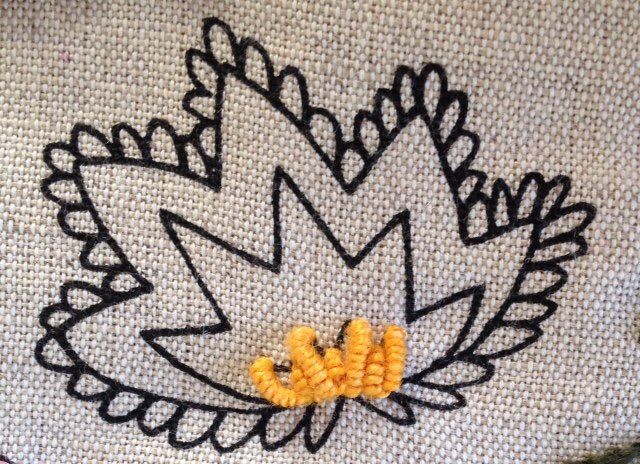
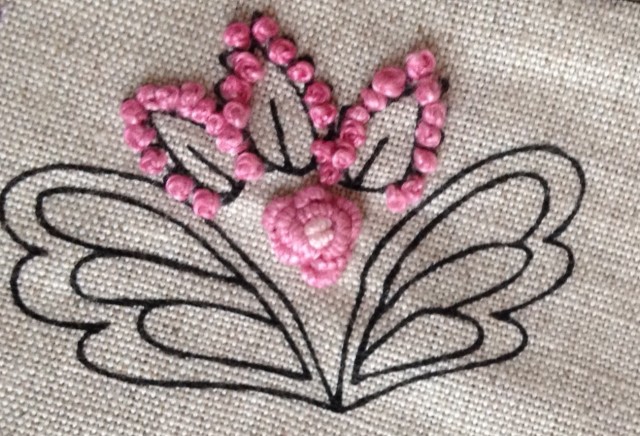
I love all kinds of knots. Here are some pictures from previos works. At first my handbag.
You have already seen the next picture on French knot page.
The pink/mauve circles are connected by Bullion knots. The green ”worms” are also Bullion knots. The other stitches are different kinds of knotted stitches.
There are Bullion knots of different lengths on this area. The pale blue Bullion knots are my first Bullion knots ever.
The blue oval bellow is filled with dense, rised Bullion knots, and to the right there are Bullion knots surrounding a single French knot.
The handbag embroidery is all in wool.
I also tried Bullion knots on denim swatches:
Links:
Week 19
How to make Bullion knots
Google picture search
Highlights
Half Chevron Stitch was also difficult to stitch on my Paradise Flowers print. This stitch is better for borders than for flowers. But I gave it a try. The first flower looked better when I added Bullion knots.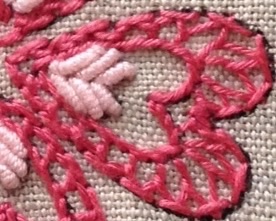
This leave looks messy and doesn’t photography well. Maybe I can improve it with Stem stitch to hide the black veins. I should have used a thinner thread.
I am not proud of my previous Half Chevron stitch either. In fact I didn’t even get them right. They are Crossed Half Chevron stitch.
Links:
Gårdagen bjöd på en högintressant sammankomst på Etnografiska museet som handlade om Indigo, Japan och Jeans. Min kurskamrat, Maria, från både broderi- och shiborikurs på Handarbetets vänner har skrivit en fyllig rapport på sin blogg. Jag hänvisar till den för dig som vill veta mer.
Som brodös gladde jag mig särskilt åt bilden från en nålfest, där man högtidligen begraver uttjänta synålar i Tofu. Nålar måste ha en särställning i Japansk kultur och gamla trasiga eller utslitna nålar är inget man slänger hur som helst.
Dagen avslutades med en föreläsning om jeans och jag stärktes i min förvissning om att utslitna jeans inte bör hamna i soptunnan. De kan lagas på det mest fantastiska sätt, klippas i trasor och vävas till vackra mattor eller klippas i lappar som sedan sammanfogas till nya plagg.
Efter gårdagens sammankomst har mina tankar snurrat kring möjligheten att förena mina båda intressen för odling och textil. Vi fick lära oss att den Japanska indigoplantan måste fermenteras för att färgen ska frigöras. Fermenteringsprocessen sänker PH-värdet avsevärt och när man kommit ner till PH 13 är det dags att sätta igång. Då kommer jag naturligtvis att tänka på, att fermentering pågår ständigt i mitt kök, eftersom jag fermenterar matavfall till bokashi, som sedan blir en utmärkt trädgårdskompost. I somras fermenterade jag även ogräsrens och gräsklipp. Tänk om man kan göra på samma sätt med den japanska indigoplantan? Indigoplantan är ganska lättodlad, det är sedan problemen uppstår och kunskapen fattas. Jag har faktiskt odlat indigo för några år sedan men lyckades aldrig få fram någon färg att tala om. Nu längtar jag redan till nästa odlingssäsong, så att jag får testa igen.
Fröer till indisk indigo finns hos impecta.se och bokashiströ hos bokashi.se.
Here are my Crossed Buttonhole stitch. I played with the length of the arms to make them fit the flower petals. These flowers need some more stitching. Thanks to TAST a suitable stitch will turn up following weeks.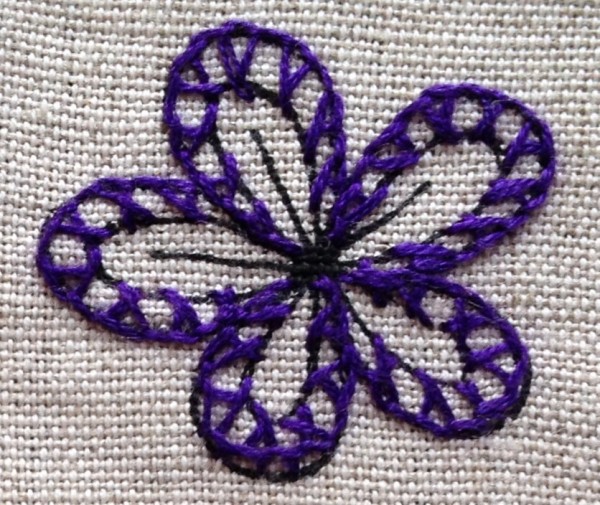
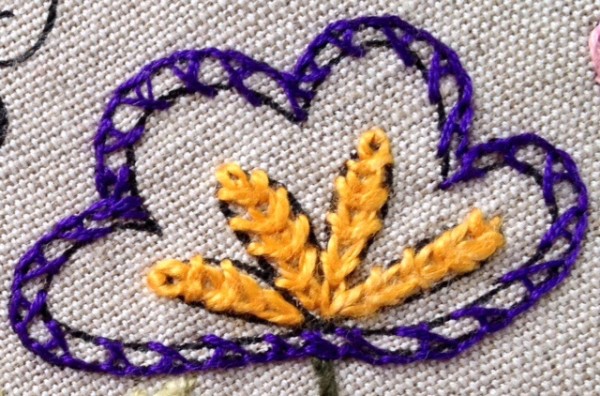
Many flowers from previous weeks have an edge of Fly Stitch. Long Armed Crossed Buttonhole stitch gives a similar but wilder effect.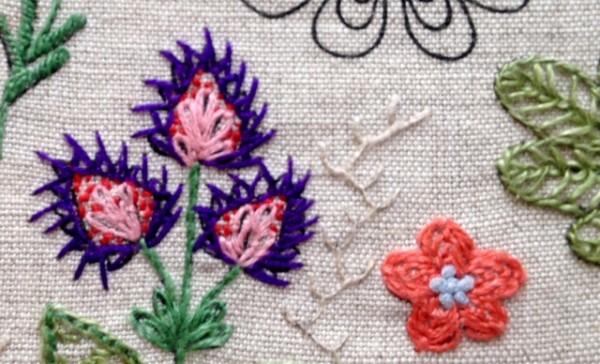
When I followed TAST 2012 I wrote: ”I did a few Crossed buttonhole stitches with two strands of floss on denim. This is a new stitch to me, so I need a lot of training to master it. It was not very difficult though.”
Links:
Wheatear Stitch is a nice little stitch. It was new to me when i followed TAST in 2012, so I didn’t try to do anything fancy. But when I now look at my swatch I can see a little ”diving bird” among my stitches? Can you see it?
After my first swatch I havn’t used Wheatear Stitch until now. It is a beautiful stitch very useful for ”Paradise Flowers”.
Links: